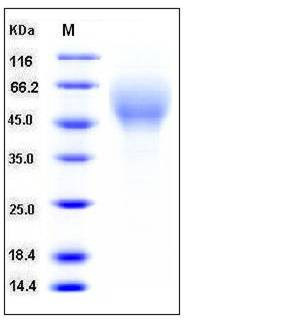Mouse CD200R4 / CD200 Receptor 4 / CD200RLa Protein (His Tag)
Cd200r4,F630107N04Rik,MCD200RLa
- 100ug (NPP3220) Please inquiry
| Catalog Number | P50639-M08H |
|---|---|
| Organism Species | Mouse |
| Host | Human Cells |
| Synonyms | Cd200r4,F630107N04Rik,MCD200RLa |
| Molecular Weight | The secreted recombinant mouse CD200R4 comprises 227 amino acids and has a predicted molecular mass of 25 kDa. As a result of glycosylation, the apparent molecular mass of rm CD200R4 is approximately 50-60 kDa in SDS-PAGE under reducing conditions. |
| predicted N | Thr 26 |
| SDS-PAGE |  |
| Purity | > 96 % as determined by SDS-PAGE |
| Protein Construction | A DNA sequence encoding the extracellular domain of mouse CD200R4 (NP_997127.1) (Met 1-Thr 241) was expressed, fused with a polyhistidine tag at the C-terminus. |
| Bio-activity | |
| Research Area | Immunology |Cluster of Differentiation (CD) |Other CD Antigen |
| Formulation | Lyophilized from sterile PBS, pH 7.4 1. Normally 5 % - 8 % trehalose, mannitol and 0.01% Tween80 are added as protectants before lyophilization. Specific concentrations are included in the hardcopy of COA. |
| Background | Mouse Cell surface glycoprotein CD200 receptor 4, also known as Cell surface glycoprotein OX2 receptor 4, CD200 cell surface glycoprotein receptor-like 4, CD200RLa, and CD200R4, is a single-pass type I membrane protein which belongs to the CD200R family. CD200 (OX2) is a cell surface glycoprotein that interacts with a structurally related receptor (CD200R) expressed mainly on myeloid cells and is involved in regulation of macrophage and mast cell function. In mouse there are up to five genes related to CD200R with conflicting data as to whether they bind CD200. CD200R4 contains one Ig-like C2-type (immunoglobulin-like) domain and one Ig-like V-type (immunoglobulin-like) domain. CD200R4 is highly expressed in monocytes, NK cells and a subset of NKT cells. It is weakly expressed in granulocytes and B cells (at protein level). CD200R4 is also expressed in brain, lung, testis, thymus, intestine and uterus. and in bone marrow derived-macrophage and dendritic cells and mast cells. CD200R4 is involved in the recruitment or surface expression of the TYROBP receptor. |
| Reference |
